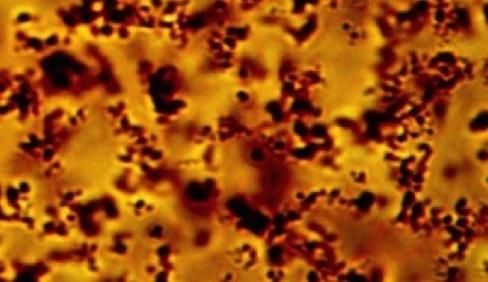Asphaltene analysis takes a giant step
Rice researchers develop accurate measure of aggregating particles that block oil production lines
Rice University researchers have developed an easy and accurate technique to detect and quantify the amount of asphaltene precipitated from crude oils, which bedevils the oil industry by clogging wells and flow lines.

Asphaltenes (in black) clump together in a model oil created for testing in a Rice University lab. Researchers have created a new method for more accurate detection of asphaltenes that can clog oil production lines.
Vargas Lab/Rice University
Asphaltene is a complex of hydrocarbon molecules found in crude. As the name suggests, it has uses as the source of asphalt for road construction and can also be made into waterproofing and roofing materials, corrosion inhibitors and other products.
But in wells, asphaltene can slow or even halt production as changes in the pressure, temperature and composition of oil as it rises can deposit the material on pipes, pumps and valves. Producers have strategies to prevent or remove deposits, so it's valuable to know where they're likely to form.
The new Rice study led by Francisco Vargas, an assistant professor of chemical and biomolecular engineering, puts forth what he calls an indirect method that combines gravimetric (centrifugation) and spectroscopic techniques.
In experiments, the method not only detected and measured asphaltene from very low to very high content in pure crude and model oils, but also detected smaller asphaltene particles than can be sensed with industry-standard direct methods. The study appears in the American Chemical Society journal Energy and Fuels.
Vargas likened the problem with asphaltene to human arteries clogged by cholesterol deposits. "Our ultimate objective is to assure the continuous production of oil," he said. "If those wellbores get clogged, regardless of what the problem is, the oil cannot flow."
Asphaltene deposits were recognized as an issue nearly a century ago, but the problems they present has become more pressing because "we're running out of easy (to extract) oil," he said.
"Up to now, companies would extract the easiest 30 percent of the oil in an underground reservoir and move on," Vargas said. "Now they have to go back and try to find an economic way to extract that more expensive oil."
He said enhanced oil recovery techniques that pump carbon dioxide into a well to force oil out can change the composition of the reservoir. "Asphaltenes that were stable are not any longer," he said.
The industry has relied on near-infrared spectroscopy and microscopy methods to detect asphaltene precipitation under high-temperature, high-pressure conditions, but neither can sense particles smaller than 0.5 to 1 microns, so they are somewhat limited in their application, Vargas said. The Rice lab's indirect method detects the presence of particles as small as 100 nanometers (one-tenth of a micron) with the same near-infrared instrument currently used by industry.
Rather than look at the sum of asphaltene in two types of oil they studied - Middle East crude and model oil created in the lab - the Rice lab used a centrifuge to remove asphaltene particles larger than 100 nanometers. That allowed them to measure the optical density of the remaining liquid to detect the precipitation of asphaltene and quantify the amount precipitated.
By adding various amounts of heptane, which prompts precipitation, and/or toluene, a solvent that dissolves and stabilizes asphaltene aggregates, the Rice researchers controlled the suspension of the remaining small particles in their samples.
Under a spectrometer, the absorbance of the model-oil liquid itself is near zero, so any measurement of absorbed light has to be due to the presence of asphaltene particles smaller than 100 nanometers. Light absorbance differs for crude oil because even after centrifugation, maltene, an asphalt residue, clouds the picture. But Vargas said a simple calibration allows for that and returns accurate results for the asphaltene particles that remain. He noted the indirect method also accounts for the presence of water in oil, while direct methods do not.
Other researchers have found asphaltene particles can be as small as 2.5 to 6 nanometers.
"But these particles, which they call nano-aggregates, are stable and do not cause problems," he said. "We are interested in the larger particles that form deposits.
"As far as we know, this is the only method that can simultaneously detect the onset of precipitation and quantify the amount of asphaltene precipitated," Vargas said.
He said future work will apply the indirect method to oil samples under the kinds of pressure found in production lines, as well as potential production impairment caused by asphaltene deposition in reservoirs.
Topics
Organizations
Other news from the department science

Get the analytics and lab tech industry in your inbox
From now on, don't miss a thing: Our newsletter for analytics and lab technology brings you up to date every Tuesday. The latest industry news, product highlights and innovations - compact and easy to understand in your inbox. Researched by us so you don't have to.
Most read news
More news from our other portals
See the theme worlds for related content
Topic World Spectroscopy
Investigation with spectroscopy gives us unique insights into the composition and structure of materials. From UV-Vis spectroscopy to infrared and Raman spectroscopy to fluorescence and atomic absorption spectroscopy, spectroscopy offers us a wide range of analytical techniques to precisely characterize substances. Immerse yourself in the fascinating world of spectroscopy!

Topic World Spectroscopy
Investigation with spectroscopy gives us unique insights into the composition and structure of materials. From UV-Vis spectroscopy to infrared and Raman spectroscopy to fluorescence and atomic absorption spectroscopy, spectroscopy offers us a wide range of analytical techniques to precisely characterize substances. Immerse yourself in the fascinating world of spectroscopy!
Topic world Centrifugation
Centrifugation is an indispensable process in the life sciences. By using centrifugal forces, it enables the separation of cells, proteins and other biomolecules according to size and density. Whether in the purification of therapeutic proteins, the isolation of DNA/RNA or the separation of cell cultures - centrifugation plays a central role in biological and pharmaceutical research and production.

Topic world Centrifugation
Centrifugation is an indispensable process in the life sciences. By using centrifugal forces, it enables the separation of cells, proteins and other biomolecules according to size and density. Whether in the purification of therapeutic proteins, the isolation of DNA/RNA or the separation of cell cultures - centrifugation plays a central role in biological and pharmaceutical research and production.





















































